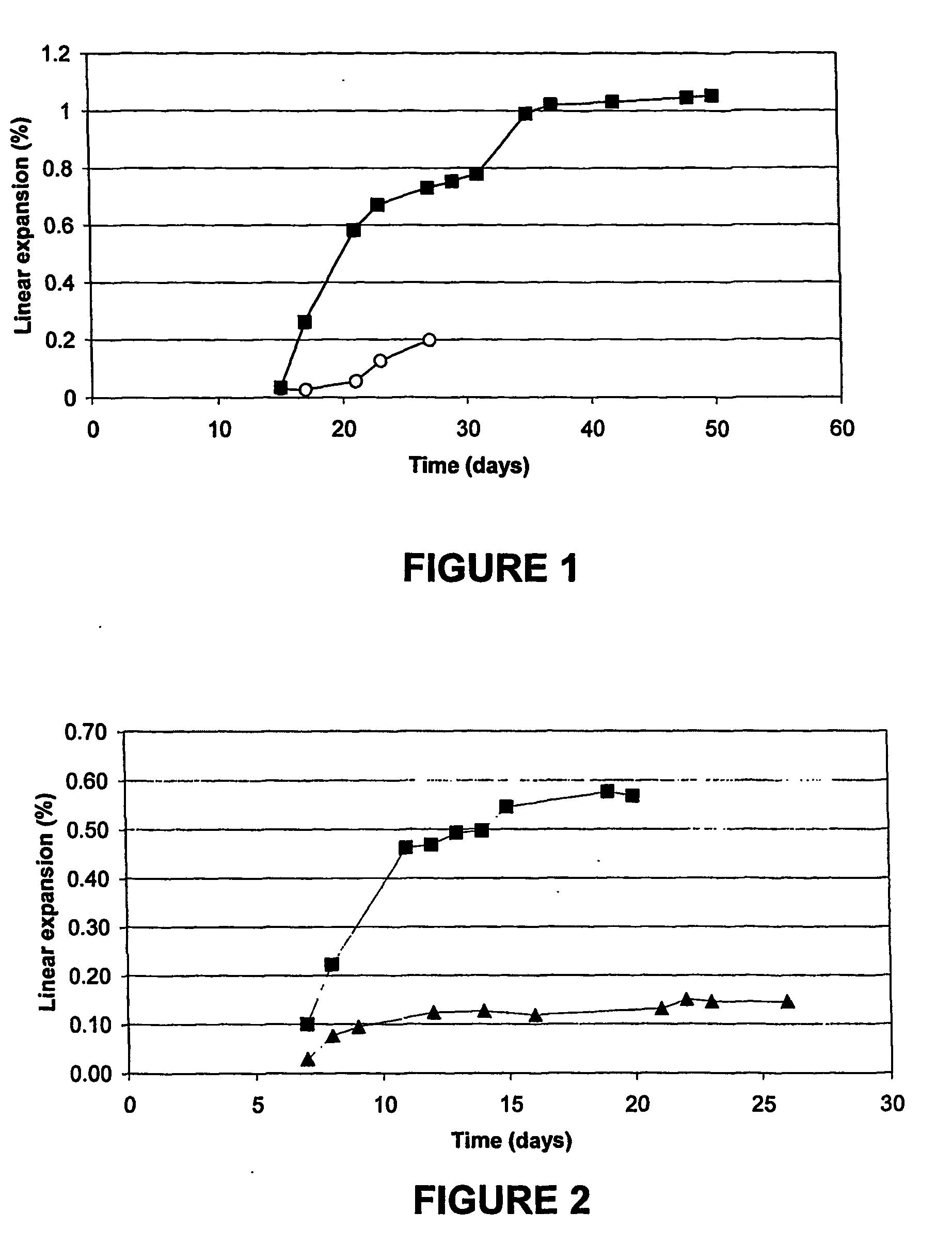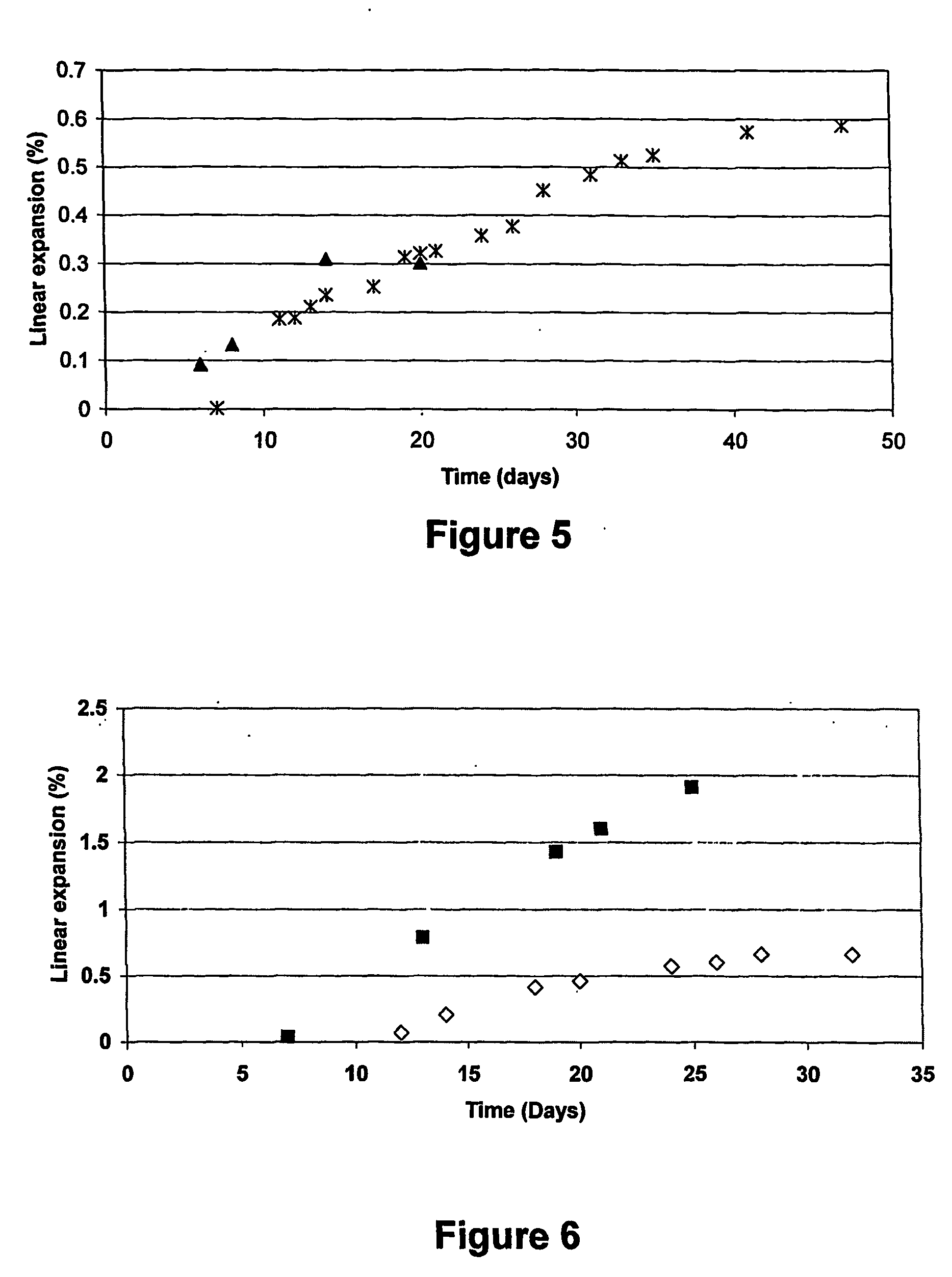Self adaptive cement systems
a cement system and self-adaptive technology, applied in the direction of solid waste management, chemistry apparatus and processes, sustainable waste treatment, etc., can solve the problems of deterioration of sheath, inability to immediately apply to well cementing operations, and inability to absorb water
- Summary
- Abstract
- Description
- Claims
- Application Information
AI Technical Summary
Benefits of technology
Problems solved by technology
Method used
Image
Examples
example 1
Ground Rubber
[0031] Two sources of ground rubber particles obtained by recycling tires were tested. GR1 particles are commercialized by American Tyre Recycler under the name “Rubber 40 mesh” have a density of 1.2 g / cm3 and an average particle size of 425μ. GR2 are commercialized by Rubber Ressources, under the product name ECORR RNM 45. The density is 12 g / cm3, the average particle size 355μ. Both are ground rubber obtained by a recycling process involving a series of shredding and special grinding operations to remove metal and fiber. These particles are black and contain a certain amount of carbon black. Recycled rubber has the advantage of being flexible and cheap. The slurry designs and rheological properties are in table 1 below in which the concentration of solid are given either by reference to the original cement blend (BVOB) or by weight of blend and the concentrations of liquid additives are given in US gallons per sack of 94 lbs of blend (in other words, 1 gpsb=88.78 cc / ...
example 2
Flexible Particles
[0036] Different types of flexible particles whose characteristics are provided table 3 were studied.
TABLE 3ChemicalProductDensitySizeCodenaturenameSupplierg / cm3(micron)F1PolypropyleneIcoreneICO0.9200-8009013 PpolymerF2AcrylonitrileChemigumEliokem1.0350butadieneP86Fcopolymer
[0037] Different slurries were prepared as for example 1, whose designs and rheological properties are shown table 4 below.
TABLE 4Formulations:A9A36A22ParticleF1F1F2Density ppg15.813.515.9Porosity %424242Cement (% BVOB)404040Fine silica (% BVOB)101010Flexible particles (% BVOB)202020Ground rubber GR1 (% BVOB)30Silica sand (% BVOB)3030Polypropylene glycol0.030.030.03(antifoam) (gpsb)Polynaphtalene sulfonate0.0100.030.01(dispersant (gpsb)Lignosulfonate (gpsb)0.0450.0450.045Rheology After mixingPV (cP)92102136Ty (lbf / 100 ft2)0.4149Rheology AfterConditioning At 60° C.PV (cP)8310499Ty (lbf / 100 ft2)6711API free water (mL)1.32Sedimentation0.05(delta bottom / top in ppg)
[0038] Linear expansion values...
example 3
Alkystyrene Particles
[0040] Imbiber beads® (a registered names of Imbibitive Technologies Corporation) are cross-linked alkylstyrene polymers engineered to absorb a broad range of organic chemicals. The beads are solid, spherical particles that are approximatively 200-300 microns in diameter. Typical application of such beads is too prevent spills from escaping into the environment. They are unaffected by water, and once contact has been made with a adequate liquid organic the beads will absorb up to 27 volumes of the organic liquid and swell up to 3 diameters depending on the liquid and on other variables such as temperature. The liquid is held in the molecular structure, the imbiber bead will not release the liquid due to compression. Its density is 1.12 g / cm3.
[0041] Beads B1 are made exclusively of alkylstyrene. Beads B2 are a mixture at a 50:50 weight ratio of alkylstyrene beads and sand. The compositions of the tested slurries are shown in table 6. Note that for slurries A17 ...
PUM
| Property | Measurement | Unit |
|---|---|---|
| density | aaaaa | aaaaa |
| density | aaaaa | aaaaa |
| diameter | aaaaa | aaaaa |
Abstract
Description
Claims
Application Information
 Login to View More
Login to View More - R&D
- Intellectual Property
- Life Sciences
- Materials
- Tech Scout
- Unparalleled Data Quality
- Higher Quality Content
- 60% Fewer Hallucinations
Browse by: Latest US Patents, China's latest patents, Technical Efficacy Thesaurus, Application Domain, Technology Topic, Popular Technical Reports.
© 2025 PatSnap. All rights reserved.Legal|Privacy policy|Modern Slavery Act Transparency Statement|Sitemap|About US| Contact US: help@patsnap.com



